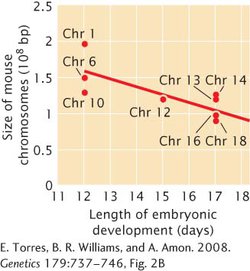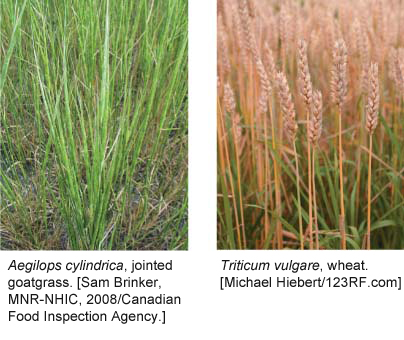APPLICATION QUESTIONS AND PROBLEMS
Question 12
12.Examine the karyotypes shown in Figures 6.1 and 6.2a. Are the individuals from whom these karyotypes were made males or females?
Question 13
*13.Which types of chromosome mutations
increase the amount of genetic material in a particular chromosome?
increase the amount of genetic material in all chromosomes?
decrease the amount of genetic material in a particular chromosome?
change the position of DNA sequences in a single chromosome without changing the amount of genetic material?
move DNA from one chromosome to a nonhomologous chromosome?
Question 14
*14.A chromosome has the following segments, where • represents the centromere:
AB•CDEFG
What types of chromosome mutations are required to change this chromosome into each of the following chromosomes? (In some cases, more than one chromosome mutation may be required.)
ABAB•CDEFG
AB•CDEABFG
AB•CFEDG
A•CDEFG
AB•CDE
AB•EDCFG
C•BADEFG
AB•CFEDFEDG
AB•CDEFCDFEG
Question 15
15.A chromosome initially has the following segments:
AB•CDEFG
Draw the chromosome, identifying its segments, that would result from each of the following mutations.
Tandem duplication of DEF
Displaced duplication of DEF
Deletion of FG
Paracentric inversion that includes DEFG
Pericentric inversion of BCDE
Question 16
16.The following diagram represents two nonhomologous chromosomes:
AB•CDEFG
RS•TUVWX
What type of chromosome mutation would produce each of the following groups of chromosomes?
AB•CD
RS•TUVWXEFG
AUVB•CDEFG
RS•TWX
AB•TUVFG
RS•CDEWX
AB•CWG
RS•TUVDEFX
Question 17
17.The green-
Question 18
*18.A wild-
ABC•DEFGHI
Researchers have found individuals that are heterozygous for each of the following chromosome mutations. For each mutation, sketch how the wild-
ABC•DEFDEFGHI
ABC•DHI
ABC•DGFEHI
ABED•CFGHI
Question 19
*19. As discussed in this chapter, crossing over within a pericentric inversion produces chromosomes that have extra copies of some genes and no copies of other genes. The fertilization of gametes containing such duplication-
As discussed in this chapter, crossing over within a pericentric inversion produces chromosomes that have extra copies of some genes and no copies of other genes. The fertilization of gametes containing such duplication-
Assume that you are a genetic counselor and that a couple seeks counseling from you. Both the man and the woman are phenotypically normal, but the woman is heterozygous for a pericentric inversion on chromosome 8. The man is karyotypically normal. What is the probability that this couple will produce a child with a debilitating syndrome as the result of crossing over within the pericentric inversion?
Question 20
20.An individual heterozygous for a reciprocal translocation possesses the following chromosomes:
AB•CDEFG
AB•CDVWX
RS•TUEFG
RS•TUVWX
Draw the pairing arrangement of these chromosomes in prophase I of meiosis.
Question 21
*21.Red–green color blindness is a human X-
Question 22
*22.Bill and Betty have had two children with Down syndrome. Bill’s brother has Down syndrome and his sister has two children with Down syndrome. On the basis of these observations, indicate which of the following statements are most likely correct and which are most likely incorrect. Explain your reasoning.
Bill has 47 chromosomes.
Betty has 47 chromosomes.
Bill and Betty’s children each have 47 chromosomes.
Bill’s sister has 45 chromosomes.
Bill has 46 chromosomes.
Betty has 45 chromosomes.
Bill’s brother has 45 chromosomes.
Question 23
*23.In mammals, sex-
Question 24
24. Using breeding techniques, Andrei Dyban and V. S. Baranov (Cytogenetics of Mammalian Embryonic Development. Oxford: Oxford University Press, Clarendon Press; New York: Oxford University Press, 1987) created mice that were trisomic for each of the different mouse chromosomes. They found that only mice with trisomy 19 completed development. Mice that were trisomic for all other chromosomes died in the course of development. For some of these trisomics, the researchers plotted the length of development (number of days after conception before the embryo died) as a function of the size of the mouse chromosome that was present in three copies (see the adjoining graph). Summarize their findings and provide a possible explanation for the results.
Using breeding techniques, Andrei Dyban and V. S. Baranov (Cytogenetics of Mammalian Embryonic Development. Oxford: Oxford University Press, Clarendon Press; New York: Oxford University Press, 1987) created mice that were trisomic for each of the different mouse chromosomes. They found that only mice with trisomy 19 completed development. Mice that were trisomic for all other chromosomes died in the course of development. For some of these trisomics, the researchers plotted the length of development (number of days after conception before the embryo died) as a function of the size of the mouse chromosome that was present in three copies (see the adjoining graph). Summarize their findings and provide a possible explanation for the results.

Question 25
25.Species I has 2n = 16 chromosomes. How many chromosomes will be found per cell in each of the following mutants in this species?
Monosomic
Autotriploid
Autotetraploid
Trisomic
Double monosomic
Nullisomic
Autopentaploid
Tetrasomic
Question 26
26.Species I is diploid (2n = 8) with chromosomes AABBCCDD; related species II is diploid (2n = 8) with chromosomes MMNNOOPP. What types of chromosome mutations do individuals with the following sets of chromosomes have?
AAABBCCDD
MMNNOOOOPP
AABBCDD
AAABBBCCCDDD
AAABBCCDDD
AABBDD
AABBCCDDMMNNOOPP
AABBCCDDMNOP
Question 27
*27.Species I has 2n = 8 chromosomes and species II has 2n = 14 chromosomes. What would the expected chromosome numbers be in individuals with the following chromosome mutations? Give all possible answers.
Allotriploidy including species I and II
Autotetraploidy in species II
Trisomy in species I
Monosomy in species II
Tetrasomy in species I
Allotetraploidy including species I and II
Question 28
28.Suppose that species I in Figure 6.25 had 2n = 10 and species II in the figure had 2n = 12. How many chromosomes would be present in the allotetraploid at the bottom of the figure?
Question 29
29.Consider a diploid cell that has 2n = 4 chromosomes: one pair of metacentric chromosomes and one pair of acrocentric chromosomes. Suppose that this cell undergoes nondisjunction, giving rise to an autotriploid cell (3n). The triploid cell then undergoes meiosis. Draw the different types of gametes that could result from meiosis in the triploid cell, showing the chromosomes present in each type. To distinguish between the different metacentric and acrocentric chromosomes, use a different color to draw each metacentric chromosome; similarly, use a different color to draw each acrocentric chromosome. (Hint: See Figure 6.24).
Question 30
30.Assume that the autotriploid cell in Figure 6.24 has 3n = 30 chromosomes. For each of the gametes produced by this cell, give the chromosome number of the zygote that would result if the gamete fused with a normal haploid gamete.
Question 31
31. Nicotiana glutinosa (2n = 24) and N. tabacum (2n = 48) are two closely related plants that can be intercrossed, but the F1 hybrid plants that result are usually sterile. In 1925, Roy Clausen and Thomas Goodspeed crossed N. glutinosa and N. tabacum and obtained one fertile F1 plant (R. E. Clausen and T. H. Goodspeed. 1925. Genetics 10:278–284). They were able to self-
Nicotiana glutinosa (2n = 24) and N. tabacum (2n = 48) are two closely related plants that can be intercrossed, but the F1 hybrid plants that result are usually sterile. In 1925, Roy Clausen and Thomas Goodspeed crossed N. glutinosa and N. tabacum and obtained one fertile F1 plant (R. E. Clausen and T. H. Goodspeed. 1925. Genetics 10:278–284). They were able to self-
Question 32
32.What would be the chromosome number of progeny resulting from the following crosses in wheat (see Figure 6.26)? What type of polyploid (allotriploid, allotetraploid, etc.) would result from each cross?
Einkorn wheat and emmer wheat
Bread wheat and emmer wheat
Einkorn wheat and bread wheat
Question 33
33. Karl and Hally Sax crossed Aegilops cylindrica (2n = 28), a wild grass found in the Mediterranean region, with Triticum vulgare (2n = 42), a type of wheat (K. Sax and H. J. Sax. 1924. Genetics 9:454–464). The resulting F1 plants from this cross had 35 chromosomes. Examination of metaphase I in the F1 plants revealed the presence of 7 pairs of chromosomes (bivalents) and 21 unpaired chromosomes (univalents).
Karl and Hally Sax crossed Aegilops cylindrica (2n = 28), a wild grass found in the Mediterranean region, with Triticum vulgare (2n = 42), a type of wheat (K. Sax and H. J. Sax. 1924. Genetics 9:454–464). The resulting F1 plants from this cross had 35 chromosomes. Examination of metaphase I in the F1 plants revealed the presence of 7 pairs of chromosomes (bivalents) and 21 unpaired chromosomes (univalents).
If the unpaired chromosomes segregate randomly, what possible chromosome numbers will appear in the gametes of the F1 plants?
What does the appearance of the bivalents in the F1 hybrids suggest about the origin of Triticum vulgare wheat?
